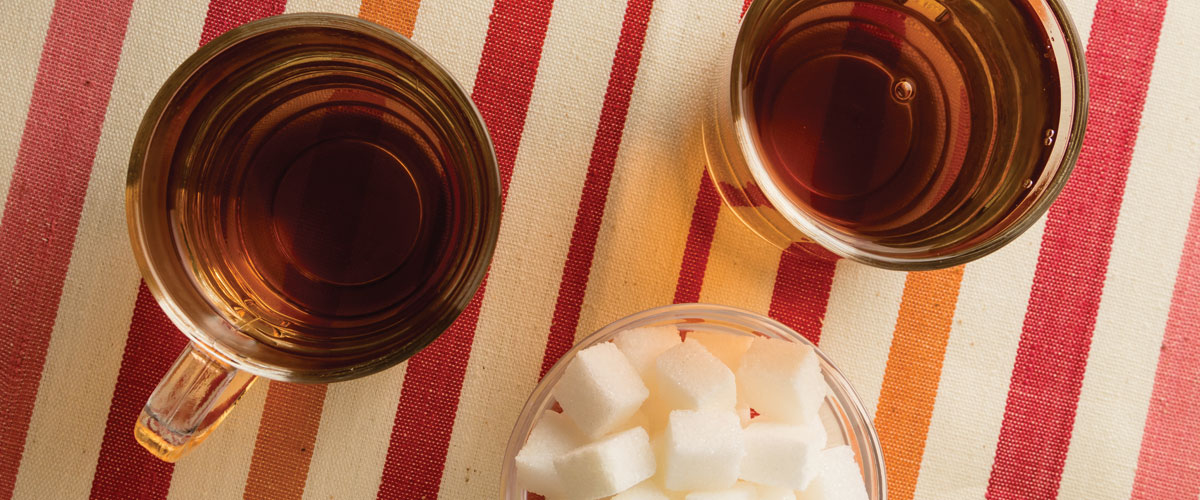One lump or two? This innocent question about how much sugar you take in your tea has a dark past, and we’re not just talking about how it came to accompany black tea.
At university I drank my way through several loyalty cards’ worth of coffee cart brews, and it wasn’t until I began working in an office that I first started drinking tea on a regular basis.
It wasn’t so much that I’d given up coffee, but that on a graduate salary (and without a campus subsidy) barista coffee was expensive and I allowed myself just one a fortnight. On the other hand, the office kitchen came kitted out with free soluble Nescafe and teabags—I forget which brand. I didn’t want to regress in my coffee drinking, so I switched to tea and committed the classic rookie error of overbrewing it, then having to adjust the bitterness with milk and sugar.
This same conundrum is said to be the reason why milk and sugar came to be common tea additives: it made a robust brew easier to drink. In some cases, it also fortified a weak infusion. When the working class switched from beer as their midday beverage to tea, the addition of milk and sugar made it almost as nutritious as a meal.
A first class folly
As with many working class trends, however, the habit of having tea with sugar actually began with the upper classes. In the 16th and 17th centuries, sugar was rare and expensive and so flagrant use of it in sculptures and sprinkled on pretty much everything became a mark of wealth. When tea became popular in England in the 1660s thanks to Catherine of Braganza, wife of Charles II, who brought her tea-drinking habits from Portugal, it became a natural companion to the sweet delicacy of sugar.
By the late 17th century, doctors began issuing health warnings about excess consumption of sugar. Writer Thomas Tryon, however, suggested that something that made you feel as good as sugar must be, at some level, healthy. Although not a nutritionist, Tryon had some clout as self-help author, so when he proposed moderation, people took note.
Tryon suggested that the best way to ingest a moderate amount of sugar was to add it to a non-alcoholic herbal infusion. While he didn’t actually say ‘tea’, those who were exposed to promotion on the health benefits of tea put two and two together, thus tea and sugar became a pairing virtually endorsed by physicians—or at least influential health writers.
It took a few short decades for tea and sugar to become a staple of English upper- and middle-class diets and so by the 1730s, the demand for both commodities began to rise.
Tea and sugar at work
By the time the Industrial Revolution came into full swing in the mid-1700s, tea had replaced beer as a cheap source of energy for the working class. While beer had plenty of calories and took the edge off a long workday, tea had the same effect but also made the workers more alert. The combination of caffeine and sugar was an industrial win.
To fuel demand for both leaf and crystal, however, the British needed to secure their supply. When the balance of the tea trade tipped too far in China’s favour, Great Britain initiated the Opium Wars and, in an act of corporate espionage, sent botanist Robert Fortune undercover to China’s tea plantations, which led to the birth of commercial tea plantations in British India.
The story of sugar also contains questionable ethics. As a commodity, sugar was in decline until its serendipitous pairing with tea. The increase in demand oiled the wheels of slavery in the Caribbean, where the British had plantations. Initially, sugar plantation workers were indentured Europeans and Caribbean natives, but due to the presence of both European and tropical diseases, neither lasted very long. In their place, the British brought slaves from the African coast because they were largely resistant to those afflictions.

What was the effect? According to Clive Ponting in his book World History: A New Perspective, the average Brit consumed four pounds of sugar in 1700 but by 1850 this was 36 pounds per head. By the end of the 18th century, plantations in the West Indies produced 90% of the sugar consumed by Western Europe.
Just as sugar production looked to turn into a glut, sugar became the foundation of other products such as jams, chocolate, confectionery and sweet biscuits (all great tea accompaniments!), which maintained demand. The 19th century saw the tide turn against slavery, so newer plantations in other British colonies, including parts of Africa, Australia and the Pacific Islands, instead used indentured workers. While better than slavery, they still laboured in poverty—sugar biggest shame.
For (the) richer or poorer, tea and sugar has had a long relationship that we can today reflect upon as we fondle the sugar tongs and ask: one lump or two?

